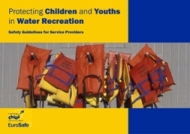Protecting Children and Youths in Water Recreation: Safety Guidelines for Service Providers
Share on social media
It is estimated that each year 50,000 Europeans in the EU 27 are injured whilst taking part in water sports or boating activities. Drowning is the second leading cause of death in young people, from infancy to 18 years of age.
 It is estimated that each year 50,000 Europeans in the EU 27 are injured whilst taking part in water sports or boating activities. Drowning is the second leading cause of death in young people, from infancy to 18 years of age.
It is estimated that each year 50,000 Europeans in the EU 27 are injured whilst taking part in water sports or boating activities. Drowning is the second leading cause of death in young people, from infancy to 18 years of age.
These water safety guidelines were developed by the European Child Safety Alliance under the umbrella of a broader project called “Safety of Services for Children’s Water-Related Sport, Tourism and Leisure Activities in the EU”.
Developed in collaboration with professional water recreation associations and injury prevention organisations across Europe, they provide informative data on injuries and hazards, and outline specific safety recommendations for many common water sports and waterside settings, in order to encourage safe water activities for children aged 0-18 years.
These guidelines were developed by combining available data, literature, and professional expertise in the area of water recreation. The activities presented were selected based on a combination of their frequency in tourist settings, their real and perceived injury risks, as well as the likelihood of participation by children. The recommendations in this guide are not an exhaustive list of all safety requirements and regulations, rather, they intend to pinpoint aspects of child injury risks which are often overlooked in standard operating plans and safety schemes.
Service Providers' Responsibilities
The Guidelines highlight, among other things, the responsibilities of those who hire out equipment for water sports or manage facilities where water recreation in included. The safety of these services is a key issue, not only to ensure their enjoyment by tourists but also because of the legal implications which accidents may have for the owner.
Table of Contents
Introduction 1
Water safety fact sheets
Tourism and water-related injuries 2
Alcohol and water recreation 7
Protecting your business and your customers
Responsibilities of service providers in the EU 8
The importance of risk assessment 9
Criteria for assessment of safe services 10
Guidelines for specific activities and settings
Swim sports
Snorkeling 11
SCUBA diving 13
Boating sports
Canoeing and kayaking 16
Sailing 19
Personal Watercraft 21
Motorboats 23
Tow sports (water-skiing, tow inflatables) 25
Wind sports
Kite surfing 27
Windsurfing 30
Water settings
Safety by the waterside 32
Swimming pools on holiday properties 34
Waterslides 36
Further resources 38
European Child Safety Alliance country partners 41
References 46
Acknowledgements 47
Further information is available at the website of the European Child Safety Alliance.
Download the Child and Youth Water Safety Guidelines in PDF format, from the right-hand panel.
